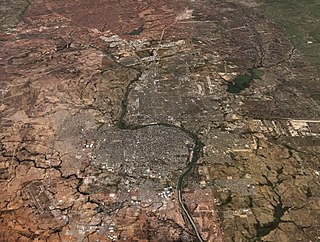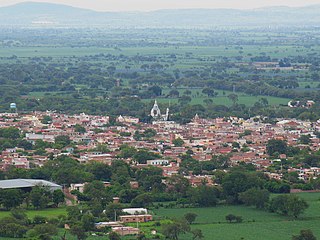
Our Lady of Guadalupe, also known as the Virgin of Guadalupe, is a Catholic title of Mary, mother of Jesus associated with a series of five Marian apparitions to a Mexican peasant named Juan Diego and his uncle, Juan Bernardino, which are believed to have occurred in December 1531, when the Mexican territories were under the Spanish Empire.

The Treaty of Guadalupe Hidalgo officially ended the Mexican–American War (1846–1848). It was signed on 2 February 1848 in the town of Guadalupe Hidalgo.
Coatepec Harinas is one of 125 municipalities in the State of Mexico, Mexico. The municipal seat is the town of Coatepec Harinas. The original name is "Coauhtepetl" which means 'serpent hill' in Náhuatl. Around 1825 because of a boom in flour production, the name "Harinas" was added.

Gustavo A. Madero is the northernmost borough of Mexico City.

The Basilica of Santa María de Guadalupe, officially called Insigne y Nacional Basílica de Santa María de Guadalupe is a basilica of the Catholic Church, dedicated to the Virgin Mary in her invocation of Our Lady of Guadalupe, located at the foot of the Hill of Tepeyac in the Gustavo A. Madero borough of Mexico City. It belongs to the Primate Archdiocese of Mexico through the Guadalupana Vicariate, which since November 4, 2018, is in the care of Monsignor Efraín Hernández Díaz, who has the title of general and episcopal vicar of Guadalupe and abbot of the basilica.

San Juan del Río is a city and administration of the surrounding San Juan del Río Municipality in the central Mexican state of Querétaro. The population in for the municipality is 268,408 as of 2015.

Fray José Servando Teresa de Mier Noriega y Guerra was a Roman Catholic priest, preacher, and politician in New Spain. He was imprisoned several times for his controversial beliefs, and lived in exile in Spain, France and England. His sermons and writings presented revisionist theological and historical opinions that supported republicanism.

Ciudad Nicolás Romero is the largest city and municipal seat of the municipality of Nicolás Romero in State of Mexico, Mexico. It is located 58 km from the city of Toluca, the state capital and lies in the north-central part of the state, just northwest of the Federal District. The seat/municipality's current name is to honor Nicolás Romero, who fought for Benito Juárez during the Reform War and the French intervention in Mexico. He was executed there by the French. The town adopted this name in 1898. The area was settled by the Otomi and named Azcapotzaltongo by the Aztecs after conquering it. During colonial times, it was known as San Pedro Azcapotzaltongo. It was then called Monte Bajo from 1821 to 1898, when the current name was adopted. Both the municipality and city are commonly referred to as Nicolás Romero.
Villaldama is a municipality in the state of Nuevo Leon, Mexico extending over 870.5 km². Ciudad Villaldama is its principal town and seat of government. It is located in the northern part of the state, coordinates 26º30´ N and 100º25´ W., with an elevation of 420 m above sea level. It limits to the north with the municipality of Lampazos de Naranjo and to the south with Salinas Victoria; to the east with Sabinas Hidalgo and the west with Bustamante. It is located approximately 96 km from Monterrey, the state capital. Villaldama is a town in Mexico, located in Nuevo León. The locality had its maximum development when its name was Real of Mines of San Pedro Mouth of Lions, during the mining splendor of the New Kingdom of Leon towards 1690, its current name is due to the hero of the Independence of Mexico: Juan Aldama, and it changed in the year 1812.

Guadalupe is a town in the state of Zacatecas, Mexico. It is located in the central region of the state and is the head of the Municipality of Guadalupe. With a population of 170,029 inhabitants, it is the most populated city in the state and with the city of Zacatecas and surrounding towns it forms a metropolitan area. On August 1, 2010, the Camino Real de Tierra Adentro was inscribed by UNESCO on the World Heritage List, being the former Apostolic College of Propaganda Fide of Our Lady of Guadalupe, one of the sites on the cultural itinerary that reached this title, for its architectural richness and contribution to the evangelization of the north of New Spain. On June 30, 2015, the Legislative Branch of the State of Zacatecas approved that the city of Guadalupe Zacatecas be declared a Historical City, a title that came into effect on Thursday, September 3 of that same year after its promulgation in decree number 400 published in the Official Newspaper of the State of Zacatecas. On October 11, 2018 at the Fifth National Fair of Pueblos Mágicos held in the city of Morelia, Michoacán, Guadalupe received incorporation into the Pueblos Mágicos program, being the sixth to have this registration in the state of Zacatecas.

Laredo–Nuevo Laredo is one of six transborder agglomerations along the U.S.-Mexican border. The city of Laredo is situated in the U.S. state of Texas on the northern bank of the Rio Grande and Nuevo Laredo is located in the Mexican State of Tamaulipas in the southern bank of the river. This area is also known as the Two Laredos or the Laredo Borderplex. The area is made up of one county in the U.S and three municipalities in Mexico. Two urban areas, three cities, and 12 towns make the Laredo–Nuevo Laredo Metropolitan area. The two sides of the Borderplex are connected by four International Bridges and an International Railway Bridge. The Laredo–Nuevo Laredo Metropolitan area has a total of 636,516 inhabitants according to the INEGI Census of 2010 and the United States Census estimate of 2010. According to World Gazetteer this urban agglomeration ranked 157th largest in North and South America in 2010 with an estimated population of 675,481. This area ranks 66th in the United States and 23rd in Mexico.

Villa Hidalgo is a municipality in the state of Jalisco in Mexico.

Tomás Sánchez de la Barrera was a veteran Spanish captain who founded Laredo, Texas, United States, and Nuevo Laredo, Tamaulipas, Mexico, the only town in the Nuevo Santander province.

San Martín de Hidalgo, formerly San Martín de la Cal, is the largest town and municipal seat of San Martín de Hidalgo Municipality, in Jalisco in central-western Mexico. As of 2015, the town had a population of 7,819. It is located 16 km southeast of the city of Ameca and 13 km northwest of the city of Cocula.

Colonia Guerrero is a colonia of Mexico City located just north-northwest of the historic center. Its borders are formed by Ricardo Flores Magón to the north, Eje Central Lazaro Cardenas and Paseo de la Reforma to the east, Eje1 Poniente Guerrero to the west and Avenida Hidalgo to the south. The colonia has a long history, beginning as an indigenous neighborhood in the colonial period called Cuepopan. The origins of the modern colonia begin in the first half of the 19th century, but most of its development occurred as a residential area in the late 19th and early 20th. Over the 20th century, several rail lines and major arteries were built through here, changing its character Cuauhtémoc borough. It is home to two early colonial era churches, the Franz Mayer Museum and one Neo-Gothic church from the Porfirian era.

El Tepeyac National Park is one of a number of federally recognized national parks in Mexico that are protected natural areas and administered by the federal National Commission of Protected Natural Areas (CONANP), a subsidiary of SEMARNAT. It is one of the few green areas located north of the Mexico City suburbs. 95% of its territory is located in Gustavo A. Madero, D.F. Borough and 5% in the municipality of Tlalnepantla de Baz.
Colonia Valle Gómez is a colonia or neighborhood in the Venustiano Carranza borough of Mexico City, just north of the city’s historic center. The boundaries of the colonia are marked by the following streets:H.Congreso de la Unión to the east, Ferrocarril Hidalgo to the west, Río Consulado to the north and Platino Street to the south. Schools include Campanitas Preschool (public), Cendi Gdf Mapimi Primary (public), Centro de Estudios Tecnologicos Manchester Technical School (private), Cideco Preschool (private), Felipe Carrillo Puerto Primary (public), and Joaquin Miranda Carreon Primary (private).

Juan Diego Cuauhtlatoatzin, also known simply as Juan Diego, was a Chichimec peasant and Marian visionary. He is said to have been granted apparitions of Our Lady of Guadalupe on four occasions in December 1531: three at the hill of Tepeyac and a fourth before don Juan de Zumárraga, then bishop of Mexico. The Basilica of Our Lady of Guadalupe, located at the foot of Tepeyac, houses the cloak (tilmahtli) that is traditionally said to be Juan Diego's, and upon which the image of the Virgin is said to have been miraculously impressed as proof of the authenticity of the apparitions.
Celedonio Dómeco de Jarauta was a Spanish soldier, Catholic priest and later a Mexican guerrilla leader in the Mexican-American War.
















